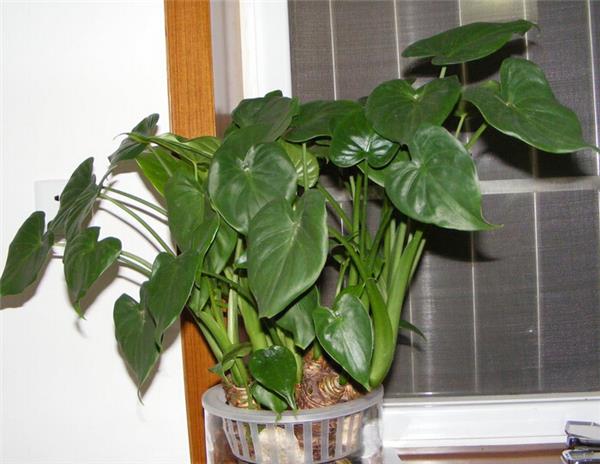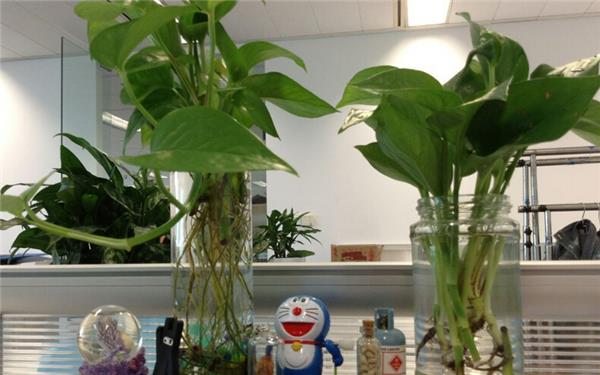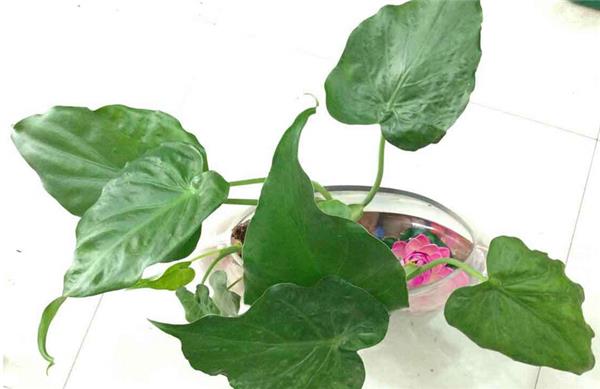The Culture method of dripping Guanyin in Water Culture A simple method to cultivate high quality dripping Guanyin
Now it has become a popular trend to raise a pot of hydroponic plants by yourself, and dripping Guanyin seems to be the choice of many people. Dishui Guanyin, also known as Dishui lotus and bergamot lotus, has broad, greasy leaves and is loved by many families. So how to breed dripping Guanyin? Let's take a look at the aquaculture method of dripping Guanyin with the editor.

Culture methods and steps of dripping Guanyin in water culture

The cultivation method of hydroponic local tax Guanyin should first change the soil planting plant into hydroponic plant by water dripping Guanyin root washing method, which should be washed carefully when washing roots, please do not damage tubers and roots, and cut off rotten roots and aging roots at the same time. If the tuber is rootless, it should be dried in a shady place for 2-3 days, and then immersed in water after the wound is dry. After 2-3 days, the new root can be seen.

In the culture method of dripping Guanyin in water culture, it should be noted that the water should be changed every 2 to 3 days at the initial stage of water culture, and the water depth should be 2 to 3 days, so that new roots can grow after 3 weeks, and then changed to nutrient solution culture after 3 weeks when the water culture plants have adapted to the water culture environment. After that, the nutrient solution will be changed once a month or so.

As a result of dripping Guanyin stem tissue is relatively loose, such as poor water quality is easy to be polluted and cause rotten roots and stems rot. Therefore, to keep the bottle water clean, we should also wash the mucus on the tubers and roots and cut off the rotten roots in combination with changing water or back culture solution.

Dripping Guanyin is an indoor foliage plant, the leaves of foliage plants are relatively large, transpiration is relatively strong, transpiration is large, and more water is emitted into the air. Dry weather makes everything in a state of lack of water, so this season to keep a pot of dripping Guanyin at home, you can breathe moist air when you get home. So, while raising Dishui Guanyin, how should we protect it?
Problems needing attention in the maintenance of Dishui Guanyin
Temperature
It likes warmth and grows rapidly when it is more than 25 ℃. The most suitable temperature for growth is 25-30 ℃. It has a certain ability to resist cold, and the overwintering temperature can be maintained above 2 ℃.
Light-2.
Like semi-overcast, can not bear the exposure of strong sunlight. From May to September, shade should be provided to cover about 50% of the sun. The rest of the time should be given plenty of sunshine. Do not tolerate excessive shading, otherwise the petiole becomes thinner and longer, not only the plant shape is not beautiful, but also easy to break.

-- 3. Watering
Because the leaves are huge and consume more water, so they are afraid of drought. Like the slightly wet soil environment, during the growth period of watering to master "dry and wet and wet", watering should be adequate, even if it is watered more. Especially in the hot summer, we should pay more attention to the supply of water to meet the water requirements of the plant. Because of the large leaf surface, water droplets often spit out at the leaf tip in the morning, which is very strange, so it is known as "dripping Guanyin". However, it is required to keep the basin soil moist at ordinary times to ensure that the plant absorbs enough water and rely on the root pressure of the plant to transport the water to the leaf tip and spit it out; when the basin soil is dry, there will be no water to drop. In winter, the moisture should be controlled to keep the basin soil slightly moist, as long as the leaves are not soft and sagging; if the basin soil is too wet, it is easy to lead to rotten roots.
Ambient humidity
Like the humid environment, avoid dry air, the growing season is sunny and dry, should often spray water to the branches and leaves and around, in order to maintain higher air relative humidity.
5. Fertilization
I like to be fat. Due to the large growth, it is necessary to supplement nutrients in time in order to make the stem grow stout, the leaves are large and bright green, and the leaves are small and yellow when lack of fertilizer. Nitrogen-based fertilizer should be applied every 10 days during the growth period. After autumn, people stop applying nitrogen fertilizer and topdressing 230 phosphorus and potassium fertilizer. Stop fertilizing in winter.
Pruning
Yellow leaves should be cut off at any time. Because the petiole is long, it is necessary to avoid breaking the petiole when moving, placing and maintaining. If it is injured, it should be cut off in time.
7. Turn the basin
The basin needs to be turned once every 1 ~ 2 years. The requirement for soil is not high, but it likes the sandy loam with fertile, loose and good drainage, and the matrix can be prepared with rotten leaf soil, garden soil, peat soil, river sand and other materials. If sufficient basal fertilizer is applied, the leaves can be enlarged. Because of the large number of leaves and small number, long petiole, moving plants and maintenance, avoid damage to leaves, otherwise it will reduce the ornamental value.
8. Reproduction
The main results are as follows: (1) sowing: wild plants often bear seeds and sow in spring. The suitable temperature for germination is 25-28 ℃, and germinates 20-25 days after sowing.
(2) insertion: it will be carried out in April. The sturdy stem is cut into stem segments of about 10 cm long with several bud eyes as cuttings, slightly dried and then obliquely inserted or lying on the seedbed, with the depth of the stem segment buried; the cuttings can also be directly planted in the basin. Keeping the substrate moist and ambient temperature 25~2TC after insertion, it can take root and survive after 4-5 weeks.
(3) ramet: potted plants are easy to produce many small plants in the base, which can be combined in April. Turn the pot to split, separate the small plant from the mother plant and plant them respectively. Ramet should be carried out when the temperature reaches 20 ℃ or higher, and new buds can be produced in about 20 days on the basis of keeping the substrate moist.
The above is the specific methods and steps of dripping Guanyin introduced by the editor, as well as how to maintain Dishui Guanyin, hoping to help you better cultivate Dishui Guanyin. Dishui Guanyin is easy to immerse people in warm dreams. Many people like its fat and green leaves and like to see water droplets rolling on the leaves. Therefore, it is suitable to be placed in a corner of halls, rooms and leisure bars after being raised in large containers of water. Small or mini water dripping Guanyin can decorate desks, computer desks and hand washing tables.
Ambient humidity
Like the humid environment, avoid dry air, the growing season is sunny and dry, should often spray water to the branches and leaves and around, in order to maintain higher air relative humidity.
5. Fertilization
I like to be fat. Due to the large growth, it is necessary to supplement nutrients in time in order to make the stem grow stout, the leaves are large and bright green, and the leaves are small and yellow when lack of fertilizer. Nitrogen-based fertilizer should be applied every 10 days during the growth period. After autumn, people stop applying nitrogen fertilizer and topdressing 230 phosphorus and potassium fertilizer. Stop fertilizing in winter.
Pruning
Yellow leaves should be cut off at any time. Because the petiole is long, it is necessary to avoid breaking the petiole when moving, placing and maintaining. If it is injured, it should be cut off in time.
7. Turn the basin
The basin needs to be turned once every 1 ~ 2 years. The requirement for soil is not high, but it likes the sandy loam with fertile, loose and good drainage, and the matrix can be prepared with rotten leaf soil, garden soil, peat soil, river sand and other materials. If sufficient basal fertilizer is applied, the leaves can be enlarged. Because of the large number of leaves and small number, long petiole, moving plants and maintenance, avoid damage to leaves, otherwise it will reduce the ornamental value.
8. Reproduction
The main results are as follows: (1) sowing: wild plants often bear seeds and sow in spring. The suitable temperature for germination is 25-28 ℃, and germinates 20-25 days after sowing.
(2) insertion: it will be carried out in April. The sturdy stem is cut into stem segments of about 10 cm long with several bud eyes as cuttings, slightly dried and then obliquely inserted or lying on the seedbed, with the depth of the stem segment buried; the cuttings can also be directly planted in the basin. Keeping the substrate moist and ambient temperature 25~2TC after insertion, it can take root and survive after 4-5 weeks.
(3) ramet: potted plants are easy to produce many small plants in the base, which can be combined in April. Turn the pot to split, separate the small plant from the mother plant and plant them respectively. Ramet should be carried out when the temperature reaches 20 ℃ or higher, and new buds can be produced in about 20 days on the basis of keeping the substrate moist.
The above is the specific methods and steps of dripping Guanyin introduced by the editor, as well as how to maintain Dishui Guanyin, hoping to help you better cultivate Dishui Guanyin. Dishui Guanyin is easy to immerse people in warm dreams. Many people like its fat and green leaves and like to see water droplets rolling on the leaves. Therefore, it is suitable to be placed in a corner of halls, rooms and leisure bars after being raised in large containers of water. Small or mini water dripping Guanyin can decorate desks, computer desks and hand washing tables.
Related
- Wuhan Hospital Iron Tree Blooming Result Was Instantly Frightened by the Gardener Master
- Which variety of camellia is the most fragrant and best? Which one do you like best?
- What is the small blue coat, the breeding methods and matters needing attention of the succulent plant
- Dormancy time and maintenance management of succulent plants during dormancy
- Minas succulent how to raise, Minas succulent plant pictures
- What are the varieties of winter succulent plants
- How to raise succulent plants in twelve rolls? let's take a look at some experience of breeding twelve rolls.
- Attention should be paid to water control for succulent plants during dormant period (winter and summer)
- Watering experience of twelve rolls of succulent plants
- Techniques for fertilizing succulent plants. An article will let you know how to fertilize succulent plants.



